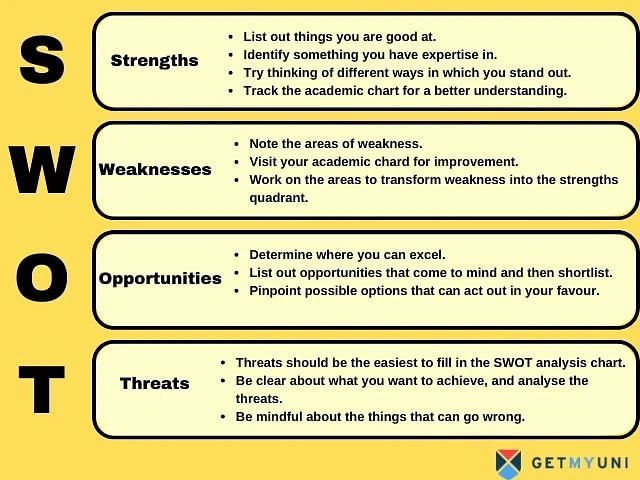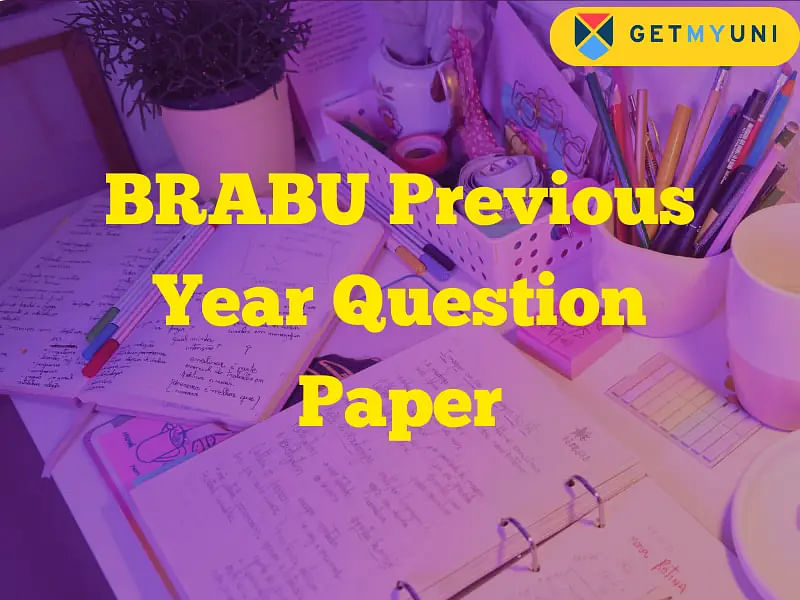Learn how to write a SWOT Analysis for students with easy steps and practical examples. Discover how to identify your strengths, weaknesses, opportunities, and threats to boost academic and personal growth.
Table of Contents
SWOT analysis for students is a self-assessment method that assists students in identifying their areas of weakness and strength. By providing a complete overview of the weaknesses, opportunities and threats it helps students achieve a clear picture of where they stand academically.
SWOT stands for Strengths, Weaknesses, Opportunities, and Threats. These four forces influence students’ course of action, since a lack of fundamental skills frequently traps students, whether they are pursuing further education or a career. Want to know how a SWOT analysis is conducted, and its advantages? Check out the details below to learn about the SWOT analysis for students in detail.
What is SWOT Analysis for Students?
SWOT stands for Strengths, Weaknesses, Opportunities, and Threats. SWOT analysis for students implies the parts they are good at and factors that need improvement on the academic front.
This analysis helps the students analyse their strengths and drawbacks in various activities such as personal development, academics, curricular activities, and growth for opportunities and potential threats. It also delves into the opportunities ahead and the threats holding them back from growth. Students may refer to the infographic to learn more about SWOT analysis:

Let us break down the SWOT analysis for students and see what each quadrant of SWOT indicates.
Strengths
The strength quadrant involves the following when performing a SWOT analysis for students:
- Listing out things a student is good at.
- Identifying areas students know will help when they are faced with a problem.
- Thinking of different ways in which students stand out from the crowd.
- Tracking the academic chart for a better understanding.
Weaknesses
The following are involved in the weakness quadrant through the SWOT analysis:
- Noting the areas where there is a scope for improvement.
- Visiting students’ academic charts for this part of the SWOT analysis will be fruitful.
- Identifying what students need to improve or move from the weakness to the strengths quadrant.
Opportunities
The opportunities quadrant of SWOT analysis for students includes the following:
- After identifying strengths and areas for improvement, students can identify where they can excel.
- List out opportunities that come to mind and then shortlist.
- Do not be too specific and list as many as you think you can achieve.
- Identify possible or different opportunities around you that can act out in your favour.
Threats
The threats quadrant of SWOT analysis for students involves the following:
- Threats should be the easiest to fill in the SWOT analysis chart.
- It is clear what you want to achieve by now, and you also know what could go wrong.
- List out things that might come in the way of your goals.
- Also, write about what scares you the most and the demotivating factor.
Also Read: Smarter Study Tips for Students to Ace Their Management Exams
Examples of SWOT Analysis for Students
Through SWOT analysis, you can analyse what opportunities lie ahead along with the strengths required to grab them and possible threats and weaknesses. Here are a few SWOT analyses for students example:
SWOT Analysis Example - Strengths
Some of the examples of the strength quadrant in SWOT analysis for students are as follows:
- What are my strengths? – “I have strong communication skills and efficiency with technology”
- In which subject do I score well? – English and Mathematics.
- Which is my favourite subject? – Basketball
- What do others see as my strengths? – “They feel I am open to new ideas.”
- What are my hobbies and interests? – “I love to paint abstract, do Indian classical dance or play the guitar.”
SWOT Analysis Example - Weaknesses
To identify weaknesses, examples of the SWOT analysis for students are provided below:
- What is my weakness? - Easily distracted and get nervous at interviews
- Which is the subject that I struggle with? – Physics
- Which is my least favourite subject? - Geography
- In which areas do I need more education or skill-based training? – “I need to learn coding and search engine optimization.”
- What are my negative traits or habits? – Impatience and procrastination
SWOT Analysis Example - Opportunities
The examples of SWOT analysis opportunities for students are as mentioned below:
- What opportunities are open to me? - “I have studied Science in class 12 which opens career avenues for Commerce and Arts too for me.”
- What are the strengths that I can turn into opportunities? – “I like to stay fit so I could appear for Defence services exams.”
SWOT Analysis Example - Threats
The examples of SWOT analysis for students to identify threats are pointed out below:
- What are the threats that could affect my chosen career field? – “The number of seats is limited in the university that I am applying to.”
- What scares me the most and is the demotivating factor? – “I have to appear for entrance exams which I am scared of, but it's the only way to get admission into good engineering colleges.”
Also Read: List of Skill Development Courses by Government in 2025
Why is SWOT Analysis Important for Students?
Performing a SWOT analysis for students will help figure out the shortcomings and provide a clearer picture of the goals. The importance of performing a student SWOT analysis is as follows:
- Making correct decisions for exploring various opportunities.
- Having a clear understanding of goals.
- Making changes in the plan to accommodate possibilities.
- Understanding choices to counteract threats.
- It keeps the students aware of their shortcomings and acts as a motivation.
- Help in utilising available resources to the best of one’s ability.
- Reviewing options and prioritizing accordingly.
There are many advantages of performing SWOT analysis as a student. The significance of the SWOT analysis may vary depending on one's goals.
Also Read: Top 5 Educational Podcasts That Are Perfect for Students in 2025
How to Conduct a SWOT Analysis for Students?
Conducting a SWOT analysis for students requires the following step-by-step process. Students need not follow a set format of steps, however, they can follow the below-mentioned steps, to begin with:

1. Identify Goals
The primary step is to identify the end goal. While doing it, the student must be fully aware of what they are working towards to achieve it. The goal set must be achievable, reliable, and within a particular time frame. Having dreams with no deadline to accomplish will leave you feeling lazy.
Achievable goals are always better than one long-term goal somewhere in the distant future.
2. Identify Strengths and Weaknesses
Now that you have defined goals for yourself, list down the strengths and weaknesses to help or prevent you from achieving them. It is true that only you know yourself better, so writing down the strengths and weaknesses relating to a goal should not be a task.
In case you are unsure, you can always consult a friend or a mentor to assist with your strong and weak points.
3. Identify Opportunities
List down things that you think will enable you to achieve your goals faster. These are usually external factors that you can leverage for yourself to move ahead in your career. Only if you're clear on your plan can you identify an opportunity that will help you move closer to accomplishing your aim.
4. Identify Threats
Threats are a superset of weaknesses that you contemplated for your SWOT analysis. Threats, however, can be external or internal. Since we covered internal threats in the weakness quadrant of SWOT, here list of external threats. These threats will act as obstacles between you and your objective.
Only if you have identified threats clearly, can you plan a counteract for them.
5. Prioritize
By now, you should be able to complete the academic SWOT analysis. Once complete, review the probe and make changes if required. Viewing the SWOT should give you a clear understanding of what you need to prioritize.
Next, look at all four areas of the SWOT analysis and start working towards your goal accordingly.
Also Check: 10 Tips for Staying Focused and Productive as A Student
Advantages of Conducting a SWOT Analysis for Students
Conducting a SWOT analysis can help students better understand themselves, set and achieve goals, make educated decisions, and adjust to changing conditions. It is an important tool for personal growth and development that can help pupils in all aspects of their lives.
- Enhanced Self- Awareness: By evaluating their strengths and limitations, students can gain self-awareness and understand where they shine and where they need to grow.
- Aim Formulation: Students can track their progress and strive toward a clear path by prioritising and setting realistic goals.
- Goal-Oriented Planning: SWOT analysis strategies can help students effectively plan and take action to achieve their goals.
- Adapting to Change: Regularly assessing and updating the SWOT analysis can help students adapt to changing conditions and make required modifications to stay on track to achieve their objectives.
- Identifying Growth Opportunities: Analysing possibilities as well as risks can assist students in identifying potential areas of growth and development.
- Self-motivation: SWOT analysis can encourage pupils by showing their strengths and providing a sense of control over their deficiencies.
- Improved Time Management: Students can improve their time management and task prioritisation by identifying potential hurdles and devising solutions to overcome them.
- Strategic Foresight: SWOT analysis helps students improve their critical thinking abilities and prepares them to handle future obstacles with confidence.
Also Read: 10 Healthy Habits for Students to Excel in Studies























POST YOUR COMMENT